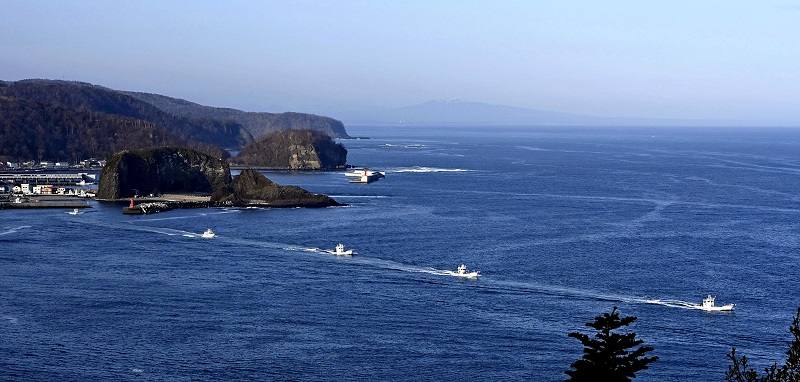
Vessels leave Utoro fishing port in Shari, Hokkaido, on Saturday morning to search for missing people who were aboard the Kazu I.
17:08 JST, April 30, 2022
SHARI, Hokkaido — The 1st Regional Coast Guard Headquarters began searching inside the sunken Kazu I sightseeing vessel Saturday, the day after its hull was spotted on the seabed at a depth of about 120 meters off the west side of the Shiretoko Peninsula in Hokkaido.
The boat went missing on April 23 with 26 passengers and crew members aboard off the Shiretoko Peninsula in the northernmost prefecture. The bodies of 14 victims have been found in nearby waters and elsewhere, but 12 remain unaccounted for.
In cooperation with private fishing vessels, search operations at sea continue for those still missing.
According to the regional headquarters, swift currents make it difficult to simultaneously operate two underwater cameras in the area where the vessel was found.
No sunlight reaches the site 120 meters below the surface. Even with a camera’s lights on, visibility is only 1 meter to 2 meters.
To determine the feasibility of inserting a camera inside the boat, the plan was for the MSDF minesweeper Izushima to first drop a camera to inspect the vessel and look through windows and doorways among other openings. Subsequently, an internal search will be conducted via a camera inserted by the JCG’s patrol vessel Erimo.
However, with limited visibility and strong tidal currents, how much detail can be obtained through cameras remains uncertain.
Prohibitive depths
The JCG wants to expedite the search inside the boat, where the bodies of missing people may remain.
However, the seabed where the boat was spotted is far deeper than the 60-meter depth limit for JCG divers to operate, making it likely that the undersea search will be difficult.
“We will decide the details of how to respond to the situation,” State Minister of Land, Infrastructure, Transport and Tourism Norihiro Nakayama told the press Friday at the Shari town government’s Utoro branch office.
The Land, Infrastructure, Transport and Tourism Ministry has set up a task force at the office.
The boat was found about 1 kilometer west-northwest of Kashuni Falls in the town of Shari on the peninsula. The waters in this area are much deeper than those closer to the shore.

Generally, water pressure only allows divers to operate at a depth of 30 to 40 meters. Even members of the Special Rescue Team, the JCG’s elite unit responsible for rescuing people from capsized vessels, can work at depths of only up to 60 meters. Under such circumstances, the MSDF used an unmanned device equipped with an underwater camera to confirm that the hull of the Kazu I had been found.
To send divers to greater depths with high water pressure, a technique called saturation diving is used. Divers must adapt themselves to high-pressure conditions in advance in a special chamber.
Only the JCG and some private companies own such equipment and possess the relevant know-how. A former JCG diver, however, said, “Even with saturation diving, underwater operations will definitely be a difficult task.”
Time required for salvage
It will likely take a certain amount of time to salvage the boat because it may be necessary to ask a private company to do so.
“The boat cannot be salvaged just yet, but examining its condition on the seabed and confirming the geographical features in the vicinity are necessary in advance,” said Katsuhiko Ikeda, 75, president of a Tokyo-based underwater exploration company specializing in research of sunken ships.
In general, a vessel is salvaged by putting ropes or nets around the hull and raising it with a crane. But it becomes harder if the target spot is on a slope or in a depression. The sea must also be calm to some extent.
“If the hull is already damaged, it will likely become more damaged during salvage, so it requires an extremely cautious approach,” said Ikeda.
In such cases, the hull may need to be reinforced before salvage. According to a source close to the JCG, such work was done in salvaging a North Korean spy ship that sank in December 2001 after trading shots with a patrol vessel.
"Society" POPULAR ARTICLE
-

M4.9 Earthquake Hits Tokyo, Neighboring Prefectures
-

Israeli Tourists Refused Accommodation at Hotel in Japan’s Nagano Pref., Prompting Protest by Israeli Embassy and Probe by Prefecture
-

M7.5 Earthquake Hits Northern Japan; Tsunami Waves Observed in Hokkaido, Aomori and Iwate Prefectures
-

Tsukiji Market Urges Tourists to Avoid Visiting in Year-End
-

High School in Kyoto Says Students Shoplifted during Recent School Trip to Bali, Indonesia
JN ACCESS RANKING
-

Tokyo Economic Security Forum to Hold Inaugural Meeting Amid Tense Global Environment
-

Keidanren Chairman Yoshinobu Tsutsui Visits Kashiwazaki-Kariwa Nuclear Power Plant; Inspects New Emergency Safety System
-

Imports of Rare Earths from China Facing Delays, May Be Caused by Deterioration of Japan-China Relations
-

University of Tokyo Professor Discusses Japanese Economic Security in Interview Ahead of Forum
-

Japan Pulls out of Vietnam Nuclear Project, Complicating Hanoi’s Power Plans























